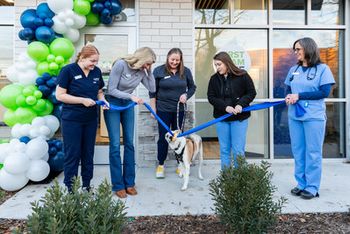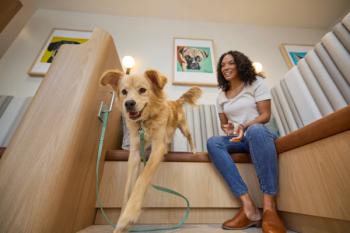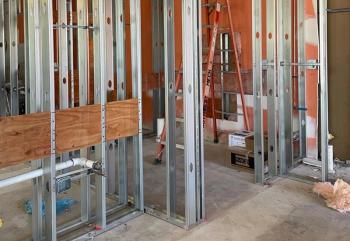
Spread the word about your new hospital
Get tongues and tails wagging with anticipation long before you open the doors of your new facility.
Your new hospital may be state-of-the-art, offer a multitude of client amenities, and boast the best location in town, but you can't rely on the new facility to sell itself. Reaching out to clients, prospective clients, and the community through marketing and communication efforts is just as important now as it was in your old hospital—probably more so. Your new building represents change. In many ways, we humans are not as adaptive as our furry friends, and we tend to resist change. While you see all the wonderful attributes of your new place, clients may see a longer drive, a farther walk to the door, or a group of unfamiliar doctors. They may also be thinking, "Look at this place—you know our veterinary bills are going up!"
Consider what the move means to your staff, clients, prospective clients, rescue groups, referral sources, and the local community. This is the perfect time to reexamine your communications with these audiences and turn your move into a positive and exciting development. The mistake that many veterinary practices—and other small businesses—make is that they fail to consider how to make news of a new facility resonate with their audiences. So follow these steps to get new and old clients alike eager to sniff around your new hospital.
Put yourself in their shoes
Your current clients might enjoy the "corner vet" feeling of your existing practice. Or they may like the fact that you're conveniently located next to a pet supply store. Before making any type of announcement about your new facility, consider how folks will react to the news. Determine what benefits you'll need to communicate to make the change meaningful and enticing. Also, identify any potential objections to the change. Make note of how you believe the following audiences will react to the move. Consider the answers to these questions and think about what selling points will get people not only to accept but embrace the new facility.
Clients
> Will they have to drive farther?
> Will they feel comfortable in the new facility?
> Will they be paying more for services?
> Will they be interacting with different people?
Rescue groups
> What kind of attention will they get at the new facility?
> How convenient will your new location be for volunteers?
> Does the new facility enable space for adoptable pets?
Others
> What features will referral sources want to know about?
> How will the move impact vendors and service providers?
> What new opportunities exist for partners and collaborators?
Mark your territory
Determine how you'll articulate what the new facility is and what it represents. What's new? How's it different? Why should anyone care? How will you describe the new hospital? Is your practice still ABC Veterinary Clinic, or do advanced diagnostics, on-staff specialists, and a regional clientele warrant a more sophisticated market identity? Perhaps your practice has evolved to care for exotics. Or maybe you've adopted a holistic approach. Take time to develop written definitions and descriptions of the new facility. Determine whether you'll need to change these items:
> Your tag line and descriptors
> Your logo and other graphic elements you use to brand your hospital
> Your signage
> Your Web site
> Your stationery and business cards
If you've already refined your practice's identity and market positioning, your move into a new facility will go much more smoothly. A word of caution, however. Too many changes confuse people. A new name and a new building could have people asking, "What happened to Dr. So-and-so?" Remember that communication is a process. If possible, ease into the change through a series of messages. This is much more effective and personal than a single mailed postcard announcing, "We've moved!"
Get the pack on board
If your team is unhappy, clients will notice. Make your employees part of the design process. Your architect doesn't have to work there; your team does. And they may have suggestions for improving the design. What gets your team excited? What are their concerns? Think through the questions that may be weighing on team members' minds:
> Will they have to drive farther?
> Will they have to work longer hours?
> Will their duties change?
> Will they need to clean more exams rooms?
> Will they have to walk farther to the lab?
> Will they be anxious about cutting costs to pay for the new facility?
> Will they feel pressure to boost business and cross-sell services?
> Will they be worried about who will clean the big new fish tank?
Staff members need more than "Didn't you get the memo?" to become engaged. Communicate with your team frequently to generate interest and buy-in. Reexamine staff reward and recognition programs and consider that you might need to enhance them in the new facility.
Get tails wagging
You're now ready to launch your new hospital. Start by identifying each audience that could influence the success of your new facility:
> Team members and their families and friends
> Clients and groups of clients segmented by demographics (seniors, young families) or by type of pet
> Prospective clients, which you may also want to segment
> Rescue groups and shelters
> The local power structure (political, animal welfare, school, and religious leaders)
> Referral sources and other veterinarians
> Suppliers and vendors
> Neighboring businesses
> Civic, community, and cultural groups
> Local media
Plan your communications with each of these groups before your move, if possible. Orchestrate the timing of your messages so that your communication is closely tied together. This will help prevent the spread of incorrect information and also enable you to be proactive with each group's message.
Take a program approach to developing a new hospital launch plan. Create a series of events, communications, and initiatives that send a cohesive message to your target audiences. For example, a series of on-site healthy pet workshops, such as "how to keep your pet out of the veterinary hospital," sends a message that you're concerned about saving clients money and you're looking out for their pets. Incorporating a theme and purpose adds impact, continuity, and meaning to your communications.
Once you've developed on your approach, determine how to make the hospital opening attention-getting and interesting. Consider:
> A grand opening
> VIP tours and previews for local officials and the media
> Tours and demonstrations of the hospital for the general public
> Special introductory services or promotions
> Contests and drawings
> Tours and briefings for the local media
> Commemorative gifts for clients and referral sources
> Donations to local shelters and animal rescue groups
> Guest speakers or seminars
Where possible, use your existing communication channels (your Web site, client newsletter, e-mail bulletins, signage, bulletin boards, mailed reminders, and so on) to spread the word. Since you're using them already, they can be an economical way to get your message out.
Give out lots of kisses
When clients arrive at your new facility, show them you're excited to see them—every time. High-tech equipment and a big-screen TV in the lobby can't replace trust, comfort, and emotional ties. Here's an example: Our five cats and four rabbits put us on the veterinary A-list. We've been to the high-tech, state-of-the-art new hospital with the big exam rooms that's close to home. Yet we choose to drive 42 miles one way to a 50-plus-year-old clinic in the country. Why? It's simple. Our veterinarian refers to one of my kitties as, "you little pork chop." He e-mails me with test results and appointment confirmations. And everyone there is smiling when we enter.
Keep in mind that for the lay person, the new radio surgical device you added to your armament will probably not be the talk of the town. However, I've told no less than 50 people about the doctor who kissed my orange tabby on the forehead after his dental surgery.
When it comes down to it, your clients are your best method of marketing the new hospital. Hands down, no comparison. Their word of mouth—whether it's excitement, gratitude, frustration, or disappointment—will spread like wildfire. So how can you light a positive spark? Find out what clients think of the new facility. Or if you're in planning stages, what would they like to see you do differently? Consider these strategies:
> Make finding the new facility memorable and easy.
> Improve your use of technology to strengthen client communication.
> Add value through access to new information and client resources.
> Make clients and their pets part of the celebration.
Keep your ears up
If you use an existing client relationship management system, modify or add to it to track the results of your marketing and communications initiatives. As your new hospital grows, you'll want to know the best sources of new clients and the return you get for your efforts. Make gathering feedback from team members and clients a regular practice at your new facility.
Newsletter
From exam room tips to practice management insights, get trusted veterinary news delivered straight to your inbox—subscribe to dvm360.





